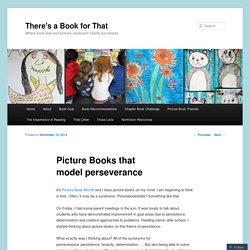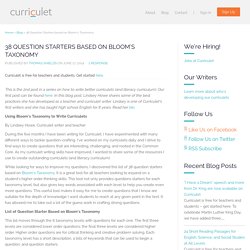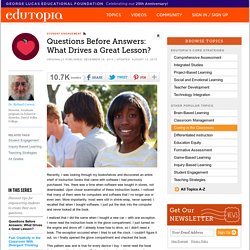

Engaging Learners through the Power of Questioning - Teacher Professional Development. High Order Thinking Chart. Reflections from an Elementary School Principal: Encouraging a growth mindset. Here's a cross-post from my staff memo blog...

Last school year I learned a great deal from the book Mindset, by Carol Dweck and shared my learning with you in this post. I don't know if anyone else also read this book, but I am starting to notice a lot of classroom practices and teachers talking in ways to encourage students to have a growth mindset versus a fixed mindset. In one classroom, students were discussing the following quote: "We all make mistakes. That's why a pencil has an eraser. " I've been lucky enough to get into several classrooms during the math talk time to hear students explain their thinking or to see students writing to "Puzzled Penguin" to tell him what math mistake he made.
In another classroom during science stations, students were told "Don't worry if you get it wrong, just try to think of what it might be and then check to see if you're right. EDUC 512 Week 5 ← APU EdTech. The Machine is Us/ing Us Depth of Knowledge Check out Hess’ Cognitive Rigor Matrix, which correlates Depth of Knowledge with Bloom’s Taxonomy.

Bloom’s Revised and Depth of Knowledge working together… Activity: Collaborative Web 2.0 Google Presentation This activity on Webb’s Depth of Knowledge and Web 2.0 tools will have us all working as a group to create a Google Presentation. We will create a Google Presentation highlighting Web 2.0 tools as they correlate to Webb’s Depth of Knowledge. The Google Presentation has already been created. Part One: Each student must create AT LEAST two slides that showcases a Web 2.0 tool and the corresponding level and description of Webb’s Depth of Knowledge (other than Facebook, Twitter, or YouTube) that can be used to support the curriculum.
GROWTH MINDSET. Picture Books that model perseverance. It’s Picture Book Month and I have picture books on my mind.

I am beginning to think in lists. Often. It may be a syndrome. Picturebooklistitis? Something like that. On Friday, I had some parent meetings in the a.m. Developing a Growth Mindset in Teachers and Staff. The New Psychology of Success (2000), Dweck developed a continuum upon which people can be placed, based upon their understandings about where ability comes from. For some people (at one end of said continuum), success (and failure) is based on innate ability (or the lack of it). Deck describes this as a fixed theory of intelligence, and argues that this gives rise to a ‘fixed mindset’.
At the other end of the continuum are those people who believe success is based on a growth mindset. These individuals argue that success is based on learning, persistence and hard work. According to Dweck: In a fixed mindset students believe their basic abilities, their intelligence, their talents, are just fixed traits. The crucial point for individuals is that these mindsets have a large impact upon our understanding of success and failure. Needless to say, this idea of mindsets has significant implications for education. A Guide to Depth of Knowledge: 5 Tips to Help Your Students.
View Original Photo How do you know that the tasks your students complete will meet the rigorous standards of the Common Core?

Upgrade your KWL Chart to the 21st Century. One of the take aways from the Curriculum Mapping Institute this past week was that it brought an upgrade to THE trusted KWL (Know, What to Know and Learned) Chart to the forefront.

It seems a no brainer…one of those things… “I should have thought about it”… So what is this upgrade all about? An “H” snuck into the Acronym! What does this “H” stand for”? Why is this an upgrade for the 21st century? I started out by searching Google, which immediately wanted to correct my search term and showed me the traditional “KWL chart” results. The top search results turned out mostly downloadable files for templates, which was quiet interesting as there were several explanations in these tutorials what the “H” could stand for: HOW can we find the answers to these questions? In direct relation to our quest to bring Information literacy in the 21st century to our teachers and students, the “HOW will we find the information” sticks out right away for me. Related 12. 38 Question Starters based on Bloom’s Taxonomy - Curriculet. Curriculet is free for teachers and students.

Get started here. This is the 2nd post in a series on how to write better curriculets (and literacy curriculum). Our first post can be found here. In this blog post, Lindsey Howe shares some of the best practices she has developed as a teacher and curriculet writer. Developing-21st-century-critical-thinkers-infographic-mentoring-minds.jpg (JPEG Image, 500 × 773 pixels) How We Think: John Dewey on the Art of Reflection and Fruitful Curiosity in an Age of Instant Opinions and Information Overload. By Maria Popova “To maintain the state of doubt and to carry on systematic and protracted inquiry — these are the essentials of thinking.”

Decades before Carl Sagan published his now-legendary Baloney Detection Kit for critical thinking, the great philosopher, psychologist, and education reformer John Dewey penned the definitive treatise on the subject — a subject all the more urgently relevant today, in our age of snap judgments and instant opinions. In his 1910 masterwork How We Think (free download; public library), Dewey examines what separates thinking, a basic human faculty we take for granted, from thinking well, what it takes to train ourselves into mastering the art of thinking, and how we can channel our natural curiosity in a productive way when confronted with an overflow of information.
Dewey begins with the foundation of reflective thought, the defining quality of the fruitful, creative mind: This is where the art of critical thinking becomes crucial. Rigorpresentation_KH11.pdf. 249 Bloom's Taxonomy Verbs For Critical Thinking. Bloom’s Taxonomy’s verbs–also know as power verbs or thinking verbs–are extraordinarily powerful instructional planning tools.

In fact, next to the concept of backwards-design and power standards, they are likely the most useful tool a teacher-as-learning-designer has access to. Why? They can be used for curriculum mapping, assessment design, lesson planning, personalizing and differentiating learning, and almost any other “thing” a teacher–or student–has to do. Questions Before Answers: What Drives a Great Lesson? Recently, I was looking through my bookshelves and discovered an entire shelf of instruction books that came with software I had previously purchased.

Yes, there was a time when software was bought in stores, not downloaded. Upon closer examination of these instruction books, I noticed that many of them were for computers and software that I no longer use or even own. More importantly, most were still in shrink-wrap, never opened. I recalled that when I bought software, I just put the disk into the computer and never looked at the book. What Do You Do With An Idea?
Minds in Bloom. 25 Question Stems Framed Around Bloom's Taxonomy. 25 Question Stems Framed Around Bloom’s Taxonomy While critical thinking is a foundation rather than a brick, how you build that foundation depends on the learning process itself: exposing students to new thinking and promoting interaction with that thinking in a gradual release of responsibility approach.

Question stems can be a powerful part of that process no matter where the learner is. Assessment (pre-assessment, self-assessment, formative and summative assessment), prompting and cueing during discussion, etc. In that light, the following 25+ question stems framed around the early, non-revised Bloom’s Taxonomy are worth a gander. DOK_Chart.jpg (JPEG Image, 1700 × 2200 pixels) - Scaled (45%)